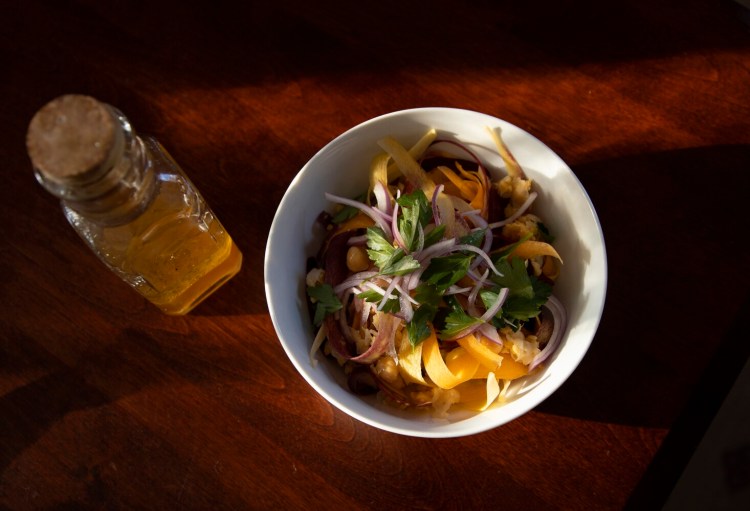Fast casual food chains aren’t normally how I spend my dining out dollars.
Frequenting small, independent restaurants that tap local producers for their raw ingredients better keeps my hard-earned cash circulating inside Maine’s food economy. But I will admit I have the Panera app on my phone. The chain’s Topsham location sits on the short side of the isosceles triangle connecting my daughter’s former high school with the ballet and modern dance studios she attended. When I was designated driver to pick her up, I could place an order for a chicken Caesar salad with extra dressing, avocado and a slice of baguette as I waited in the parking lot of one class and pick the order up as we passed Panera so she could refuel while I chauffeured to her second rehearsal of the night.
As a dance mom, I was more attuned to the number of calories the meal offered than to the carbon footprint producing it left behind. But as the first participant in the World Resources Institute’s Cool Food Meals program, Panera now gives me the opportunity to weigh my options for dishes that carry smaller carbon footprints. My daughter’s chicken Caesar salad, like 55 percent of the chain’s menu items, carries the Cool Food Meals seal of approval. The overall goal is to reduce food-related greenhouse gasses from 2015 to 2030 by 25 percent.
The WRI is a data-driven, nonprofit organization based in Washington, D.C., that creates programs intended to effect widespread behavioral change in humans’ consumption habits as a way to manage natural resources more wisely and equitably. The WRI makes no bones about its efforts to push more eaters to choose more plant-forward options more often, at the expense of high-emissions beef and lamb options.
“Count it. Change it. Scale it.” That’s the WRI motto.

The recipe calls for lightly mashed chickpeas. The onions are soaked briefly in water to tame their bite. Derek Davis/Staff Photographer
What WRI researchers count in the Cool Food Meals program is the carbon dioxide equivalent (CO2e) of all ingredients in a main course meal. They define a meal as at least a six-ounce (170 grams) portion containing at least 40 grams of foods from at least two of the primary food groups.
The CO2e of any ingredient is determined by its agricultural supply chain greenhouse gas emissions and its carbon opportunity costs. Supply chain emissions occur on farms to produce both human food and animal feed and include livestock-related emissions (enteric fermentation, manure management, livestock wastes on pastures), emissions from soil fertilization and energy use, and emissions related to transportation, packaging, processing and food waste. Carbon opportunity costs estimate the “missed potential carbon sink” if the land used to produce the food sourced by the food provider were instead able to return to its native vegetation.
In North America, researchers have determined that to reach the 25 percent reduction by 2030, each person’s daily allowable CO2e should be just shy of 18, 20 percent of which (3.6 CO2e) is to be taken at breakfast and 30 percent (5.4 CO2e) to be taken at lunch and dinner. The remaining 20 percent of calories are allocated to snacks, beverages and desserts.
A few examples on Panera’s menu that hit the mark (and carry the Cool Food Meals badge of honor on the menu) are the Ten Vegetable Soup (0.97 kg of CO2e per meal); Broccoli Cheddar Soup (3.64 kg of CO2e per meal); the Mediterranean Bowl (1.74 kg of CO2e per meal) containing rice and quinoa, fresh vegetables, hummus and Greek yogurt; the Fuji Apple Salad with Chicken (4.48 kg of CO2e per meal); and the Chipotle Chicken Avocado Melt (5.25 kg of CO2e per meal).
You won’t see these numbers listed on the menu – probably because CO2e values are not as universally understood as calorie counts are – but both Panera and WRI are hoping the presence of the Cool Food Meals logo will help drive their sales as eaters change their eating habits to help fight climate change.
WRI spokesman Gerard Pozzi wouldn’t tell me where consumers might next see the Cool Meals logo, but he did say the organization was working with a number of large, national restaurant chains and hopes to expand the Cool Food Meals initiative outside of the United States later this year.
In the meantime, either hit Panera to show your support, or stay home and make this meatless, low-emission, highly satisfying salad.
Christine Burns Rudalevige is a food writer, recipe developer, tester and cooking teacher in Brunswick, and the author of “Green Plate Special,” a cookbook from Islandport based on these columns. She can be contacted at: cburns1227@gmail.com

Use carrots of many colors, if you can find them, for a standout dish. Derek Davis/Staff photographer
Shaved Carrot, Chickpea and Parsley Salad with Honey-Apple Cider Vinaigrette
Using multi-colored carrots for this recipe makes an impression. I use a potato peeler all the way to the carrots’ core. When the stub is too small to safely shave, I toss it in the freezer bag for stock.
Serves 4
¼ cup thinly sliced red onion
1½ pounds carrots
½ cup picked parsley leaves
1½ cups chickpeas, slightly smashed
¼ cup olive oil
2 tablespoons apple cider vinegar
1 tablespoon honey
½ teaspoon kosher salt
¼ teaspoon crushed black pepper
Place the onions in a bowl of cold water and set aside.
Use a vegetable peeler to peel the carrots. Cut the ends off the carrots. Save the peels and ends for stock. Now use the peeler to shave the carrots into long strands into a large bowl. Drain and discard the water from the onions and add them to the carrots. Add the parsley and chickpeas.
In a small jar, combine the oil, vinegar, honey, salt and pepper. Put the lid on the jar and give it a good shake to combine. Pour the dressing over the salad. Toss well and serve immediately.
Send questions/comments to the editors.


